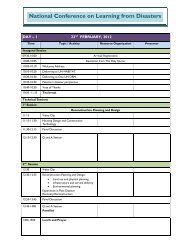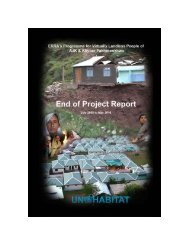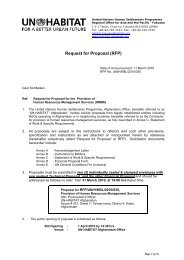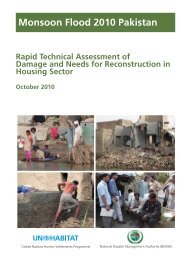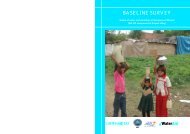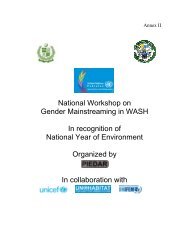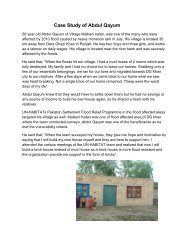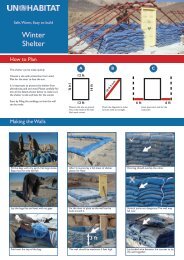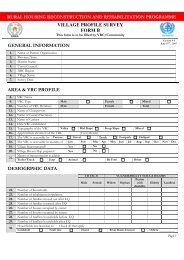Chapter-7 Land and Physical Planning Volume II - Request for ...
Chapter-7 Land and Physical Planning Volume II - Request for ...
Chapter-7 Land and Physical Planning Volume II - Request for ...
Create successful ePaper yourself
Turn your PDF publications into a flip-book with our unique Google optimized e-Paper software.
6 RECONSTRUCTION APPROACHES<br />
Shelter <strong>and</strong> Housing<br />
The policies <strong>and</strong> plans in the shelter phase should contribute to <strong>and</strong> rein<strong>for</strong>ce the<br />
development <strong>and</strong> implementation of policies in the reconstruction phase. Emergency<br />
<strong>and</strong> early recovery activities should accelerate long term recovery <strong>and</strong> ensure resources<br />
are allocated <strong>for</strong> permanent reconstruction. Activities supporting the planning <strong>for</strong><br />
reconstruction need to start in parallel with relief stage to improve See chapter 1.<br />
Timeliness<br />
The housing sector is usually the first to start recovery as shelter is an urgent need <strong>and</strong><br />
affected communities will start to repair <strong>and</strong> rebuild their homes as soon as they are able<br />
to, with or without support or regulations. The development of policies <strong>and</strong> strategies <strong>for</strong><br />
housing reconstruction <strong>and</strong> rehabilitation need to be prioritised <strong>and</strong> developed early to<br />
ensure guidance is in time <strong>for</strong> beneficiaries, to secure funding <strong>and</strong> to guide the planning<br />
<strong>and</strong> activities of the assistance community.<br />
Strong principles<br />
The housing policy does not need to have all details worked out from the initial stage, but<br />
should be founded on clear <strong>and</strong> strong principles which can be easily communicated <strong>and</strong><br />
can guide further detailed development. it is important to build consensus <strong>and</strong> ownership<br />
on the key principles to ensure they are adhered to.<br />
People centred reconstruction<br />
All housing reconstruction needs to be based on the principle of enablement, ensuring<br />
people can take their own decisions <strong>and</strong> responsiblity <strong>for</strong> their own recovery. Financial <strong>and</strong><br />
technical support should rein<strong>for</strong>ce this principle.<br />
Flexibility <strong>and</strong> review process<br />
An ‘owner-driven’ or ‘people centred’ approach assumes that the programme will be<br />
open to respond to field needs, priorities <strong>and</strong> preferences arising over the course of<br />
implementation. This should be anticipated from the outset with associated mechanisms<br />
<strong>for</strong> feedback, transparent <strong>and</strong> regular systems <strong>for</strong> review <strong>and</strong> mid course correction.<br />
Vulnerable families<br />
It is important to identify the needs of vulnerable families during the development of<br />
policies, including potential barriers <strong>for</strong> reconstruction <strong>and</strong> options <strong>for</strong> solutions. Tracking<br />
of progress should monitor issues of vulnerability to ensure appropriate strategies are<br />
developed <strong>and</strong> implemented including additional resources or support if required.<br />
LAND EARLY AND RECOVERY:<br />
PHYSICAL PLANNING<br />
THE CONTEXT FOR<br />
HOUSING AND COMMUNITY<br />
RECONSTRUCTION<br />
CHAPTER<br />
17<br />
Cooking <strong>for</strong> the family. Maintaining everyday life in tent<br />
accommodation, winter 2005, AJK.<br />
Coordinating Strategic, regional the shelter <strong>and</strong> integrated response, planning the Federal Relief<br />
Commission <strong>and</strong> the pilot IASC Shelter Cluster<br />
Urban planning<br />
Winter shelter solutions<br />
Community based planning<br />
Migration <strong>and</strong> displacement<br />
Housing, settlement <strong>and</strong> l<strong>and</strong> use<br />
Spotaneous self recovery<br />
UN-Habitat Pakistan<br />
Dispersed rural settlement with terraced<br />
small holdings, Hattian AJK<br />
122 123
HOUSING AFTER DISASTERS GUIDE – THE ERRA EXPERIENCE IN<br />
PAKISTAN<br />
UN-Habitat is pleased to share 14 draft publications <strong>for</strong> public comments. The documents are a<br />
compilation of knowhow <strong>and</strong> lessons-learned written up by UN-Habitat’s team members in Pakistan, who<br />
were engaged in the reconstruction of housing after the Kashmir Earthquake of 8 October 2005. In the<br />
compilation of this documentation, UN-Habitat engaged with many partners, including the World Bank,<br />
under the leadership of ERRA.<br />
Until <strong>for</strong>mal publication under a partnership lead by ERRA, all rights are reserved by UN-Habitat, including<br />
of the photographs. UN-Habitat circulates this as a draft <strong>for</strong> public comments <strong>and</strong> is thus not responsible<br />
<strong>for</strong> the content produced by individual writers. The designations employed <strong>and</strong> the presentation of<br />
material in this documentation do not imply of any opinion whatsoever on the part of the Secretariat of<br />
the United Nations concerning the legal status of any country, territory, city or area or of its authorities, or<br />
concerning the delimitation of its frontiers or boundaries, or regarding its economic system or degree of<br />
development. The analysis, conclusions <strong>and</strong> recommendations in this documentation do not necessarily<br />
reflect the views of the United Nations Human Settlements Programme or its Governing Council.<br />
<br />
<br />
<br />
No part of this documentation may be reproduced, stored in a retrieval system or transmitted, in<br />
any <strong>for</strong>m or by any means, electronic, mechanical, photocopying, recording or otherwise, without<br />
prior permission of UN-Habitat, except <strong>for</strong> personal review. However, excerpts of this<br />
documentation, excluding photographs, may be reproduced, without authorization, on the<br />
condition that the source <strong>and</strong> its draft status are indicated.<br />
Comments are welcomed on this webpage. UN-Habitat reserves the right to remove any<br />
comments which are inappropriate in any way. This includes anonymous comments, which do not<br />
clearly state pertinent reasons <strong>for</strong> the anonymity. UN-Habitat will not engage in any <strong>for</strong>ms of<br />
communication or clarification on comments which it removes.<br />
The documentation may be edited by UN-Habitat only from time to time, until final publication.
7 LAND USE AND PHYSICAL PLANNING<br />
The housing sector recovery was influenced by factors of location, topography, l<strong>and</strong> use,<br />
infrastructure, economic <strong>and</strong> social development. The implementation of housing reconstruction<br />
in turn had significant impacts on l<strong>and</strong> use, natural resource management <strong>and</strong> economic <strong>and</strong><br />
social development. This chapter considers housing in the context of settlement rather than simply<br />
construction, <strong>and</strong> discusses settlement issues <strong>and</strong> institutional issues in building <strong>and</strong> planning<br />
management in the affected area <strong>and</strong> the reconstruction programme. The ERRA Rural Housing<br />
Reconstruction Programme was specifically housing <strong>and</strong> specifically rural, but also covered<br />
housing reconstruction in a number of small towns.<br />
This chapter should be read in association with chapter 6 reconstruction approaches, technical<br />
<strong>and</strong> physical chapters 8,9,10 <strong>and</strong> chapter 13 institutional development.<br />
The unprecedented investment <strong>and</strong> construction activity post disaster provided opportunities<br />
<strong>for</strong> strategic planning towards sustainable development including potentially in l<strong>and</strong> use <strong>and</strong><br />
settlements. The m<strong>and</strong>ate of ERRA <strong>and</strong> consequently the design of recovery programmes was<br />
focused primarily on the replacement of assets <strong>and</strong> services <strong>and</strong> risk reduction in construction<br />
practices rather than long term settlement concerns. This chapter refers to a number of issues<br />
not addressed or opportunities not pursued in the programme, <strong>and</strong> explains the constraints <strong>for</strong><br />
consideration in future post disaster scenarios.<br />
Guiding Principles<br />
Sector based programmes not area or integrated programming<br />
Recovery was based on programmatic sectors not on area or integrated planning. The ERRA<br />
institutional framework was based on 12 sectoral areas <strong>and</strong> programmes, policies <strong>and</strong><br />
implementation was segregated by sector.<br />
Replacement of assets<br />
Recovery planning was based on replacement of losses as priority. Sustainable future<br />
development was a secondary consideration.<br />
Capacity building<br />
Institutional <strong>and</strong> professional capacity building was focused on implementation of recovery<br />
activities rather than on long term development including institutional arrangements or<br />
professional skills in planning.<br />
Rural <strong>and</strong> urban<br />
Rural <strong>and</strong> urban reconstruction were planned <strong>and</strong> managed separately.<br />
Community mobilisation<br />
The individualised financial assistance <strong>and</strong> inspection activities should be rein<strong>for</strong>ced by social<br />
mobilisation activities to support collective planning.<br />
Sustainable housing <strong>and</strong> settlement<br />
Sustainable housing design <strong>and</strong> construction is related to sustainable settlement including<br />
natural resource management. Policies <strong>and</strong> activities should consider the individual household<br />
<strong>and</strong> the collective community levels.<br />
Increasing housing on agricultural l<strong>and</strong>.<br />
Increasing settlement with consequences<br />
<strong>for</strong> infrastructure provision<br />
Introduction / Context<br />
The affected area was substantially mountainous with steep slopes, with limited habitable l<strong>and</strong><br />
<strong>and</strong> with a high proportion of highly hazardous sites. The average agricultural l<strong>and</strong> holding was<br />
less than 2 hectares in 2005. A continuing trend of population growth was reducing the holding<br />
size <strong>and</strong> proportion of l<strong>and</strong> under agriculture as well as increasing the use of marginal l<strong>and</strong>s<br />
<strong>for</strong> settlement. Environmental degradation was further exacerbating vulnerability to l<strong>and</strong>slides,<br />
flooding <strong>and</strong> other natural hazards. There was very limited knowledge of seismic risk or mapping<br />
among authorities or communities.<br />
The ERRA Rural Housing Reconstruction Programme did not cover the officially designated cities<br />
<strong>and</strong> towns (urban areas) which were <strong>for</strong>mally under the control of development authorities <strong>and</strong><br />
municipal corporations. The official urban areas were addressed through a parallel programme<br />
that included l<strong>and</strong> use planning <strong>for</strong> the four major towns destroyed by the earthquake. The rural<br />
housing programme covered all settlements outisde of those major cities, including approximately<br />
50 smaller settlements ranging in size from 1,000 to 20,000 people. The total caseload of<br />
beneficiaries in small towns represented less than 10% of the programme. The larger of these<br />
towns were administered by town committees under local government but with limited urban<br />
planning, management or development control be<strong>for</strong>e the earthquake. The term village is used<br />
frequently in policies <strong>and</strong> reports, but the term is more an administrative <strong>and</strong> social term. There<br />
are few villages with a physical nucleus, even community facilities like mosques, schools <strong>and</strong><br />
markets are physically dispersed, or developed along arteries.<br />
The earthquake response reflects the pre earthquake situation where urban planning <strong>and</strong><br />
management was weak in terms of physical planning, building <strong>and</strong> development control,<br />
service planning <strong>and</strong> delivery <strong>and</strong> community representation <strong>and</strong> engagement. However basic<br />
<strong>and</strong> insufficient the urban planning capacity, rural <strong>and</strong> small town capacity was even more<br />
rudimentary, without institutional m<strong>and</strong>ates <strong>for</strong> l<strong>and</strong> use planning, building or development<br />
control, <strong>and</strong> consequently no existing mechanisms or capacity to use in the recovery.<br />
Key Decisions<br />
ERRA m<strong>and</strong>ate <strong>and</strong> framework<br />
ERRA was established with a clear m<strong>and</strong>ate limited to reconstruction <strong>and</strong> rehabilitation. ERRA<br />
was organised sector wise, segregating programmatically.<br />
No institutional partnership.<br />
The rural housing programme was developed with no local line department partnership<br />
from the outset. This meant that there was no <strong>for</strong>mal engagement with authorities such as<br />
Local Government <strong>and</strong> Rural Development, or the Municipal Authorities <strong>for</strong> the design or<br />
implementation of the rural housing programme or its adjustment <strong>for</strong> small town contexts.<br />
Partnership was initiated in the completion stage of the programme.<br />
Rural <strong>and</strong> urban programmes split<br />
The development of the urban <strong>and</strong> rural reconstruction <strong>and</strong> rehabilitation programme was<br />
separate <strong>and</strong> unrelated. The housing sector was split between urban <strong>and</strong> rural reconstruction.<br />
Small towns in rural policy<br />
The split between ERRA Rural Housing <strong>and</strong> ERRA Urban Housing placed small towns under<br />
Rural Housing policies.<br />
ERRA Rural Housing Programme policies promoted single storey <strong>and</strong> separate houses.<br />
The ERRA policy <strong>and</strong> st<strong>and</strong>ards promoted the construction of single storey <strong>and</strong> separate houses<br />
as seismically safer. This resulted in increased l<strong>and</strong> under housing.<br />
UN-Habitat Pakistan<br />
ERRA Environment <strong>and</strong> Disaster Risk Management<br />
The ERRA cross cutting programmes did not address integrated area planning or long term<br />
development issues. ERRA disaster risk management programmes were focused on response<br />
<strong>and</strong> preparedness rather than risk reduction <strong>and</strong> mitigation, which might have increased<br />
awareness of l<strong>and</strong> use <strong>and</strong> hazard issues or involved programmes related to settlement.<br />
High altitude settlement<br />
Lower altitude settlement<br />
Towns located in river valleys<br />
124 125
7 LAND USE AND PHYSICAL PLANNING<br />
Summary of Activities<br />
Village mapping<br />
Community mobilisation in the initial phase of the programme included village mapping<br />
exercises including physical, social <strong>and</strong> economic criteria.<br />
Technical support <strong>for</strong> small towns<br />
Technical support <strong>for</strong> small towns included development of construction st<strong>and</strong>ards<br />
appropriate <strong>for</strong> urban construction <strong>and</strong> training <strong>and</strong> awareness related to urban<br />
construction techniques.<br />
Sustainable housing <strong>and</strong> settlement<br />
From 2009 onwards technical support included activities related to housing <strong>and</strong> settlement<br />
infrastructure, services, natural resource management, risk reduction <strong>and</strong> mitigation.<br />
Support to urban authorities <strong>and</strong> urban communities<br />
Technical support activities were developed jointly with the municipal authorities<br />
in Muzaffarabad, including training of government staff <strong>and</strong> mobilisation of urban<br />
communities. The focus was on planning <strong>and</strong> building control <strong>and</strong> sustainable safer urban<br />
communities. See chapter 10.<br />
Support to Local Government<br />
From 2009, UN-HABITAT supported the Department of Local Government <strong>and</strong> Rural<br />
Development in AJK to develop capacity to manage safer <strong>and</strong> more sustainable rural<br />
housing in future, building on the development gains acheived through the ERRA<br />
programme.<br />
Sustainable settlement activities<br />
UN-HABITAT worked with the Department of Forestry, AJK <strong>and</strong> a large number of local<br />
NGOs <strong>and</strong> CBOs to develop <strong>and</strong> promote sustainable settlement <strong>and</strong> natural resource<br />
management initiatives. See <strong>Chapter</strong> 9 Environmental planning.<br />
Technical Issues<br />
Strategic planning, regional <strong>and</strong> integrated planning.<br />
Agriculture <strong>and</strong> Livelihoods.<br />
The affected areas were over 85% rural, with population densities ranging widely between<br />
sparsely inhabited high altitude locations <strong>and</strong> more densely populated low altitude <strong>and</strong><br />
better quality l<strong>and</strong>. In all affected districts of AJK property ownership is over 90%, most l<strong>and</strong><br />
holdings are small with 80% of farms under 2 hectares due to population growth <strong>and</strong> repeated<br />
subdivision. The Agricultural Census of 1990 estimated that one hectare of l<strong>and</strong> can feed a<br />
household of 10 persons <strong>for</strong> approximately 2 months. This implies that farms of 2 hectares<br />
are too small to feed the families that work them. Some families work additional l<strong>and</strong> as high<br />
altitude summer pastures or have access to communal l<strong>and</strong>s <strong>for</strong> collection of fodder in autumn to<br />
supplement their basic l<strong>and</strong>holding.<br />
The provincial <strong>and</strong> state governments are the largest non agricultural employers. In AJK the state<br />
has over 75,000 employees in adminsitration <strong>and</strong> services, over half of them in the education<br />
sector. The District Census Report in AJK records the unemployment rate at between 25-50<br />
percent of the economically active population be<strong>for</strong>e the earthquake. These figures are high<br />
compared to official Government figures from the Labour Force Survey <strong>for</strong> Pakistan, but anecdotal<br />
reports confirm long term unemployment as a serious <strong>and</strong> severe issue. The primary option<br />
<strong>for</strong> many families is to rely on remittances from family members migrating <strong>for</strong> work within the<br />
country, or overseas, usually to Saudi Arabia <strong>and</strong> the Gulf States or to the United Kingdom.<br />
One off investment opportunity<br />
The earthquake brought an unprecedented opportunity in terms of investment, political will <strong>and</strong><br />
potentially technical assistance. These could have been applied to review the patterns of l<strong>and</strong><br />
use, the economic base <strong>and</strong> to consider risks <strong>and</strong> opportunities <strong>and</strong> develop strategic responses<br />
through investment <strong>and</strong> reconstruction. One of the greatest challenges be<strong>for</strong>e the earthquake<br />
was sustainable <strong>and</strong> productive urban <strong>and</strong> rural livelihoods. ERRA’s m<strong>and</strong>ate prioritised the<br />
replacement of assets rather than economic planning or long term sustainable development<br />
issues. A degree of improving service delivery was included in the ‘build back better’ principle, but<br />
the emphasis was primarily on construction <strong>and</strong> hazard resistance. The focus was on the nature of<br />
the disaster <strong>and</strong> the physical losses rather than diagnosis of pre existing needs <strong>and</strong> opportunities.<br />
Funding <strong>for</strong> post disaster reconstruction usually follows the same pattern of replacing assets<br />
<strong>and</strong> restoring the status quo. Opening up the discussion of fundamental <strong>and</strong> underlying needs<br />
can lead to high funding requests <strong>and</strong> political wrangling over the determination of needs <strong>and</strong><br />
proposed investment plans.<br />
ERRA implemented a large scale livelihood support programme but this was designed as a<br />
relief subsidy <strong>for</strong> vulnerable households to enable them to stay at origin. Additional livelihood<br />
programmes implemented by partners focused on small scale enterprise development <strong>and</strong><br />
agricultural diversification or increasing productivity.<br />
There was not engagement with the authorities <strong>and</strong> elected representatives of the affected<br />
districts to develop a vision <strong>for</strong> economic development of the area. The unique opportunity of<br />
national <strong>and</strong> international focus <strong>and</strong> support, <strong>and</strong> the potential of the diaspora was not tapped on<br />
a macro level to support strategic long term plans or activities.<br />
<strong>Planning</strong><br />
The opportunity of the earthquake recovery investment to lift some areas out of relative poverty,<br />
to rebalance or distribute growth would have benefited from integrated area based planning<br />
rather than a strictly sectoral based approach. The sectoral based programming rein<strong>for</strong>ced<br />
divisions along project management, budget <strong>and</strong> line department m<strong>and</strong>ates. Considerable<br />
progress was made <strong>for</strong> example to improve electricity generation <strong>and</strong> access in remote areas,<br />
but these initiatives were not consolidated or considered as part of an overall or shared vision<br />
to optimize the wide range of investment <strong>and</strong> assistance. The majority of NGOs developing<br />
programmes carried out their own needs assessments <strong>and</strong> decided on areas of operation<br />
<strong>and</strong> activities based on their own criteria <strong>and</strong> community inputs but not subject to regional<br />
prioritisation or guidance.<br />
The Provincial <strong>and</strong> State <strong>Planning</strong> <strong>and</strong> Development Departments had the overarching m<strong>and</strong>ate<br />
to guide physical development programmes but had limited previous experience in regional or<br />
strategic planning or in economic development planning. The scale <strong>and</strong> complexity of planning<br />
after the earthquake brought additional challenges <strong>for</strong> their capacity. The development of<br />
integrated or strategic plans would have further required unprecedented coordination between<br />
government line departments, between district authorities <strong>and</strong> beyond government officials to<br />
include local represetatives, interest groups such as transporters, traders, farmers, women <strong>and</strong><br />
youth.<br />
The m<strong>and</strong>ate <strong>for</strong> recovery in each sector in ERRA was influenced by the overall ERRA m<strong>and</strong>ate,<br />
limiting the consideration of long term development issues. The coordination between ERRA<br />
sectors was also limited <strong>and</strong> did not build a plat<strong>for</strong>m <strong>for</strong> integrated or area based planning. The<br />
authority <strong>for</strong> planning <strong>and</strong> decision making <strong>and</strong> the control of budgets remained with ERRA,<br />
thereby limiting the potential role of the provincial or state authorities whose longer term<br />
m<strong>and</strong>ates, area <strong>and</strong> community knowledge <strong>and</strong> experience could have defined a wider discussion<br />
of needs <strong>and</strong> broader options <strong>for</strong> recovery <strong>and</strong> development. The input of line departments,<br />
provincial, state <strong>and</strong> district authorities as well as technical authorities provided valuable guidance<br />
<strong>for</strong> the development of ERRA sectoral policies <strong>and</strong> implementation, but the ef<strong>for</strong>ts were rarely<br />
consolidated on an area basis <strong>for</strong> example or considered in an integrated manner in order to<br />
diagnose or prioritise.<br />
UN-Habitat Pakistan<br />
The rapid expansion of rural population in dispersed settlement had already caused significant<br />
difficulties <strong>for</strong> the provision of publicly funded services like electricity <strong>and</strong> piped water supply.<br />
This required engagement with communities to consider the options <strong>for</strong> more sustainable<br />
development, <strong>and</strong> household <strong>and</strong> community based operation <strong>and</strong> maintenance of services.<br />
126 127
7 LAND USE AND PHYSICAL PLANNING<br />
The prioritization of target areas <strong>for</strong> development included Haveli, a remote area close to the<br />
line of control, <strong>for</strong> electrification but not <strong>for</strong> livelihood or social support, whereas a cross sectoral<br />
prioritization on the basis of development indicators could have identified priority areas <strong>and</strong><br />
guided investment across all activities <strong>and</strong> assistance agencies. The progress on easily accessible<br />
sites <strong>for</strong> school <strong>and</strong> helath sector initiatives indicates agencies were selective on the basis of<br />
access, but discriminated against remote <strong>and</strong> often low income areas many of which could have<br />
been identified as priority development <strong>and</strong> reconstruction or recovery areas.<br />
Urban <strong>Planning</strong><br />
Cities <strong>and</strong> large towns.<br />
There were four main cities in the affected area which suffered the greatest damage: Balakot,<br />
Muzaffarabad, Bagh <strong>and</strong> Rawalakot. These cities ranged in size from Balakot (around 30,000<br />
people) to Muzaffarabad (around 150,000 people). As these cities not only endured heavy losses<br />
but were also located in areas of high hazard, ERRA undertook masterplanning exercises <strong>for</strong> their<br />
reconstruction <strong>and</strong> development, <strong>and</strong> in the case of Balakot, relocation. The master planning<br />
exercises were focused on l<strong>and</strong> use in<strong>for</strong>med by microzonation. The plans included critical facilities<br />
<strong>and</strong> infrastructure, areas to promote <strong>and</strong> areas to limit development, <strong>and</strong> proposals <strong>for</strong> growth.<br />
<strong>Planning</strong> was a technical activity with less emphasis on economic or social development. There<br />
was limited capacity on the part of planners or communities to incorporate participatory processes<br />
or consultation with local stakeholders. The vision <strong>for</strong> the four urban centres did not include<br />
major initiatives which might have converted their role from service <strong>and</strong> administrative centres<br />
into engines of productive activity, with <strong>for</strong> example enterprise zones or facilities. The potential of<br />
the unprecedented funds available <strong>for</strong> investment from institutional donors, public philanthropy<br />
<strong>and</strong> the diaspora, as well as political will <strong>and</strong> technical support were not directed towards a new<br />
agenda <strong>for</strong> urban development. The urban recovery programmes reflect the recovery in general, in<br />
so far as the priority was replacement of physical assets.<br />
Be<strong>for</strong>e the earthquake, the urban authorities had limited capacities <strong>and</strong> resources to manage<br />
the implementation of services, development <strong>and</strong> maintenance of infrastructure, planning<br />
or building control. Relationships between urban communities <strong>and</strong> urban authorities was<br />
not strongly structured on any area bases, although some focus groups such as chambers of<br />
commerce, education providers, <strong>and</strong> transporter would have previously engaged with authorities.<br />
For the general population, there was no <strong>for</strong>mal system of local level mobilisation or elected<br />
representation. The lack of previous structures of representation, participation <strong>and</strong> consultation<br />
hampered the process of engagement by the community in the post earthquake planning process.<br />
Furthermore the planning process took place early during a time when many urban residents<br />
were still dealing with shelter <strong>and</strong> accommodation <strong>for</strong> their families, <strong>and</strong> livelihood issues, <strong>and</strong><br />
many had temporarily migrated <strong>and</strong> were not present at origin. Consultation tended to be a rapid<br />
process of technical experts providing in<strong>for</strong>mation to community representatives, without broad<br />
based underst<strong>and</strong>ing of the criteria, decisions, recommendations or consequences. In some cases<br />
the recommendations gained wide support, in others there was local resistance to decisisons. In<br />
all however, there was a perception that the plans belonged to the authorities <strong>and</strong> were primarily<br />
about public works, rather than also plans to guide private sector development. As described<br />
above, the plans were seen as physical plans, <strong>and</strong> did not define social or economic objectives or<br />
initaitives. The plans did however go beyond the traditional scope of l<strong>and</strong> use planning to ensure<br />
hazard <strong>and</strong> environmental issues were key considerations.<br />
The planning process <strong>and</strong> preparation of plans was a short <strong>and</strong> front loaded activity, but was<br />
not followed by sustained development of the long term responsible institutions, or sustained<br />
support to urban communities to revise, develop <strong>and</strong> implement the plans. More intensive<br />
<strong>and</strong> sustained engagement could have led to more inclusive decision making, including <strong>for</strong><br />
example reprioritisation of resources when budgets were recalibrated, community facilitation of<br />
urgent works, compliance with safety recommendations. Instead decision making was largely<br />
a technical exercise, less concerned with levels of public support or ownership. The technical<br />
support <strong>for</strong> reconstruction including training <strong>and</strong> awareness <strong>and</strong> the leveraging of compliance<br />
with st<strong>and</strong>ards through tranche payment of financial assistance was not repeated in urban<br />
housing reconstruction, <strong>and</strong> the opportunities <strong>for</strong> engagement between authorities, households<br />
<strong>and</strong> communities which was a vital part of rural reconstruction was largely absent in urban<br />
reconstruction.<br />
Muzaffarabad damage 2005<br />
Muzaffarabad uncontrolled development<br />
2010<br />
Small Towns<br />
The majority of the secondary towns in the affected districts are located on strategic but<br />
hazardous <strong>and</strong> constrained sites, with many close to rivers <strong>and</strong> cross points, on mountain ridges,<br />
or on precipitous slopes. These towns are likely to grow in the next decades including on marginal<br />
<strong>and</strong> highly hazardous l<strong>and</strong>. After the earthquake could have presented an opportunity <strong>and</strong><br />
access to technical skills to look at hazard mapping <strong>for</strong> these towns, avoiding reconstruction on<br />
critically hazardous areas <strong>and</strong> identification of areas <strong>for</strong> planning control in the future. It may<br />
have been possible to carry out essential risk reduction measures <strong>and</strong> mitigation works. These<br />
strategic locations will continue to be the focus of activity <strong>and</strong> construction <strong>and</strong> with increasing<br />
development the potential losses also increase. There were several multi-storey mixed use private<br />
buildings reconstructed at trading centres particularly on steep sites along with high occupancy<br />
buildings such as markets, hotels, mosques <strong>and</strong> private schools. These structures needed not only<br />
l<strong>and</strong> use planning guidance but also engineering advice. They were outside of the planning <strong>and</strong><br />
building control purportedly available in larger urban areas, <strong>and</strong> outside the ERRA based control in<br />
small towns which was limited to houses reconstructed after the earthquake. ERRA did not plan<br />
<strong>for</strong> proactive technical guidance <strong>for</strong> st<strong>and</strong>ards <strong>for</strong> community <strong>and</strong> private multi storey buildings.<br />
The Seismic Provisions in the Pakistan Building Code were available from 2007, but not easily<br />
communicated or adopted at field level.<br />
While the priority concern after 2005 was earthquake risk, it should be noted that the affected<br />
area suffers every year from l<strong>and</strong> <strong>and</strong> mud slides triggered by spring <strong>and</strong> summer monsoon rains.<br />
They can also be affected by the impact of heavy snows. Un<strong>for</strong>tunately the floods in February<br />
2010 caused extensive damage to riverside construction in Hattian town, <strong>and</strong> the historic floods<br />
after torrential monsoon rain at the end of July 2010 caused further damage to many riverside<br />
settlements in NWFP <strong>and</strong> AJK.<br />
Smaller towns could have been easier to guide with technical support than the very complex<br />
major cities. Participatory planning might have been more feasible in contexts with smaller<br />
numbers of stakeholders <strong>and</strong> less political issues. <strong>and</strong> with smaller numbers of stakeholders. This<br />
could have provided a <strong>for</strong>um to assess damage, hazards <strong>and</strong> risks, to discuss plans <strong>and</strong> identify<br />
needs <strong>for</strong> technical st<strong>and</strong>ards, guidance, training <strong>and</strong> in<strong>for</strong>mation, to develop stakeholder groups<br />
such as market traders, <strong>and</strong> to develop consensus on priorities <strong>and</strong> actions. issues like solid waste<br />
disposal could have been rationalised <strong>and</strong> upgraded, disaster preparedness plans <strong>for</strong> mosques,<br />
markets <strong>and</strong> other community places could have been developed.<br />
This did not necessarily require extensive capital investment, rather it required accessible technical<br />
advice to enable relatively well resourced communities to make better decisions <strong>for</strong> recovery.<br />
Most of all it required the catalytic role of community mobilisation <strong>and</strong> participatory planning <strong>for</strong><br />
people to think, plan <strong>and</strong> act collectively. Institutional investment in the authorities responsible<br />
<strong>for</strong> smaller town development would have been helpful, but was considered outside of the<br />
scope of reconstruction <strong>and</strong> rehabilitation <strong>and</strong> would need to be subject to the m<strong>and</strong>ate of<br />
other <strong>for</strong>a. However, the reconstruction also provided an opportunity to accelerate institutional<br />
re<strong>for</strong>m institutional development <strong>and</strong> institutional capacity building. ERRA might have considered<br />
whether the Housing Reconstruction Centres could have provided a service of guidance <strong>for</strong> the<br />
small towns in their respective areas, including engineering advice <strong>for</strong> non residential private<br />
buildings, <strong>and</strong> support <strong>for</strong> authorities <strong>and</strong> communities <strong>for</strong> planning <strong>and</strong> development.<br />
UN-Habitat Pakistan<br />
Small town construction, often several<br />
storeys due to incremental growth <strong>and</strong><br />
steep sites. Chikar.<br />
128 129
7 LAND USE AND PHYSICAL PLANNING<br />
URBAN RECONSTRUCTION, PLANNING AND SETTLEMENT<br />
SMALL TOWNS, RECONSTRUCTION, PLANNING AND BUILDING CONTROL<br />
ACTIVITIES<br />
ERRA developed master plans <strong>for</strong> 4 large towns affected by the earthquake integrating disaster risk management in the<br />
planning process.<br />
Balakot town was planned to be relocated to a safer site with extensive investment in infrastructure.<br />
Housing reconstruction was managed by a single cash payment, with no conditions, st<strong>and</strong>ards or guidance.<br />
RESULTS<br />
The city masterplans focused on a series public infrastructure projects, with successful reconstruction of government<br />
facilities. Separate project management <strong>for</strong> reconstruction agency capital projects.<br />
Limited engagement with the private sector in the development of plans, or in the promotion or en<strong>for</strong>cement of safer<br />
housing or commercial reconstruction or development.<br />
Limited support <strong>for</strong> institutional development in planning or building control or risk management.<br />
The bazaar is central to the life of the city, but requires building <strong>and</strong> planning<br />
control <strong>and</strong> preparedness planning <strong>for</strong> this heavily populated area.<br />
<strong>L<strong>and</strong></strong> is scarce <strong>and</strong> expensive, marginal <strong>and</strong> hazardous l<strong>and</strong> is being used <strong>for</strong><br />
construction without adequate engineering mitigation.<br />
Tariqabad, Muzaffarabad rapidly growing in<strong>for</strong>mal settlement at risk of flooding,<br />
l<strong>and</strong>sliding <strong>and</strong> earthquakes.<br />
Balakot, attempts to relocate the residents to a new safer site have been slow,<br />
the existing location is commercially strategic although hazardous. .<br />
ACTIVITIES<br />
Small towns were outside of the ERRA urban reconstruction programmes, under the Rural Housing Reconstruction<br />
Programme.<br />
Over 200 small <strong>and</strong> medium towns had very rudimentary management systems be<strong>for</strong>e the earthquake <strong>and</strong> no effective<br />
planning or building control. Many are in hazardous <strong>and</strong> strategic locations at river <strong>and</strong> valley crossing points.<br />
Support provided through the ERRA rural programme <strong>for</strong> communities on safer construction<br />
Support provided through the departments of local government <strong>and</strong> rural development to strengthen risk management.<br />
RESULTS<br />
Opportunities to engage with communities <strong>and</strong> authorities were constrained by policy <strong>and</strong> resource deficits.<br />
The scale of the rural programme deflected attention away from the relatively minor issue of small towns.<br />
Progress made in the promotion of safer construction with technical solutions <strong>and</strong> bespoke advice developed <strong>for</strong> the<br />
urban typologies present, including focus on steel fixing, commercial frame buildings <strong>and</strong> quality assurance.<br />
Main street in a small town, centre <strong>for</strong> trade, social <strong>and</strong> communication activities<br />
Increasingly dense in site coverage <strong>and</strong> building heights with pressure on services<br />
<strong>and</strong> increasing risk<br />
UN-Habitat Pakistan<br />
Rear of buildings on the same street, picture left. Steep sites resulting in multi<br />
storey RCC frame construction, often partially completed.<br />
Kundal Shahi, neelum valley, combination of traditional <strong>and</strong> new RCC<br />
construction. Towns located at busy river crossings connecting communities.<br />
Urban growth, rapid infill with development on environmentally fragile l<strong>and</strong>.<br />
Rural construction types on the edge of the city<br />
Increasing storey heights increasing building vulnerability <strong>and</strong> risk.<br />
Area based plan <strong>for</strong> Muzaffarabad prepared in 2006 but not materialised.<br />
New housing with investment in finishes, but with poor knowledge of seismic<br />
safety. Private <strong>and</strong> public hazard. Poor access to in<strong>for</strong>mation available.<br />
Increasing population in towns with poor urban services management or<br />
community based initiatives to h<strong>and</strong>le challenges like solid waste.<br />
130 131
7 LAND USE AND PHYSICAL PLANNING<br />
Community Based <strong>Planning</strong><br />
Village Mapping<br />
The Rural Housing Reconstruction Programme included activities called ‘village mapping’<br />
under the terms of reference of village reconstruction committees to be facilitated by partner<br />
organisations. The objective was to increase collective underst<strong>and</strong>ing of l<strong>and</strong> use <strong>and</strong> sustainable<br />
development issues in the village, to increase underst<strong>and</strong>ing of hazards <strong>and</strong> to promote collective<br />
actions in mitigation <strong>and</strong> risk reduction, to support engagement with government departments<br />
<strong>and</strong> NGOs on the planning <strong>and</strong> implementation infrastructure <strong>and</strong> community facilities. The<br />
extensive destruction in many villages meant that it was necessary to reconstruct entire markets,<br />
mosques, schools, <strong>and</strong> other facilities <strong>and</strong> consider the reduction of risk through better selection<br />
of sites or to consider growth or new needs.<br />
However in the majority of villages l<strong>and</strong> was in very short supply, alternative sites were rarely<br />
available or considered, <strong>and</strong> reconstruction took place on the same site as be<strong>for</strong>e. In the locations<br />
where schools were adjudged by geological <strong>and</strong> engineering survey to be inappropriate <strong>for</strong><br />
construction of community facilities <strong>and</strong> key structures like schools or basic health units, it proved<br />
extremely difficult to find alternatives <strong>for</strong> a number of reasons, technically there is limited flat safe<br />
l<strong>and</strong>, economically, it is very difficult to purchase alternative l<strong>and</strong>, socially, it is very difficult to get<br />
agreement in the community about relocation, including arguments over who benefits. The high<br />
costs dem<strong>and</strong>ed by owners was not always related to an issue of value, it was also related to the<br />
perceived opportunity of reconstruction budgets.<br />
Village mapping did not become a comprehensive process integrating the plans of various sectors,<br />
particularly as it was driven through the housing reconstruction sector, which was focused on<br />
individual households who did not move unless the participated in the l<strong>and</strong>less programme<br />
(see chapter 5). The segregation of sectors into ERRA sectoral programmes was rein<strong>for</strong>ced by<br />
segregation of activities by line departments <strong>and</strong> a range of partner organisations. Community<br />
infrastructure rehabilitation <strong>and</strong> development such as link roads <strong>and</strong> water supply was more<br />
feasible <strong>for</strong> discussion through village mapping or in relation to physical planning, <strong>for</strong> example<br />
how many households would benefit from or contribute to various schemes. Mitigation works<br />
<strong>for</strong> hazardous l<strong>and</strong>s were developed by AKDN based on cost benefit depending on how many<br />
households / houses would be protected by the measures.<br />
In general, housing <strong>and</strong> settlement was too dispersed <strong>and</strong> was based on reconstruction in situ to<br />
require or benefit from village mapping exercises. Given the lack of dem<strong>and</strong> the majority of VRCs<br />
did not engage in this activity as it was defined in the ERRA strategy. Instead of village mapping<br />
documenting l<strong>and</strong> use <strong>and</strong> physical in<strong>for</strong>mation, villages focused on collecting <strong>and</strong> using other<br />
in<strong>for</strong>mation such as the list <strong>and</strong> contact details of skilled masons, carpenters <strong>and</strong> steelfixers in<br />
order to facilitate training <strong>for</strong> example, identification of vulnerable households, <strong>and</strong> other socio<br />
economic in<strong>for</strong>mation, <strong>and</strong> the selection of locations <strong>for</strong> demonstration works, in<strong>for</strong>mation<br />
displays or other community activities.<br />
Participatory planning capacity<br />
Several villages, with trading centres, or with key natural resources such as river courses, or<br />
with high hazards, <strong>and</strong> with other concerns like rapid degradation could have benefited from<br />
community based discussion of physical development issues, to help access technical advice<br />
if appropriate, or as a means to build awareness <strong>and</strong> local consensus. The role of planning<br />
facilitators could have been to unearth local knowledge, to precipitate local priorities, <strong>and</strong> to<br />
galvanise the community into action. The highly dispersed pattern of settlement also represented<br />
a new challenge in terms of housing, settlement, l<strong>and</strong> use <strong>and</strong> natural resource management<br />
outside of the conventional skills of the planning profession who may have been better equipped<br />
to address urban settlement.<br />
Engineers employed in the department of Local Government <strong>and</strong> Rural Development were<br />
familiar with working with communities on planning <strong>and</strong> implementation of basic infrastructure<br />
programmes. Their m<strong>and</strong>ate or experience would not have included facilitating discussions<br />
with communities about their own plans <strong>and</strong> resources. Their training would generally not<br />
have included skills in community consultation or mobilisation <strong>and</strong> depended on their personal<br />
experience or aptitude. They were not usually familiar with PRA or other tools <strong>for</strong> community<br />
engagement. Engineers with NGO experience were familiar with community implementation, but<br />
not necessarily in a facilitation role. Social mobilisers <strong>and</strong> community organizers may have had the<br />
skills to faciliate community discussion, but not necessarily to guide the discussion in terms of l<strong>and</strong><br />
related or physical development works.<br />
Training in engineering or in l<strong>and</strong> use planning in Pakistan as in many countries was predicated on<br />
technical professionals as experts rather than facilitators. Experience with communities was usually<br />
predicated on communities as sub contractors or beneficiaries, rather than the main responsible<br />
actors <strong>and</strong> decision makers. While there are notable exceptions in rural programmes such as the<br />
AKRSP <strong>and</strong> urban programmes such as the Orangi pilot project, there was not a large corps of<br />
technically competent planners with training or experience in participatory <strong>and</strong> community driven<br />
development. Trained planners are few overall in the country, employed generally by Government<br />
authorities <strong>and</strong> in a small number of private commercial development consultancies. The ambition<br />
to bring planning skills to several hundred villages, or even to the 50 small towns in the affected<br />
would have required extensive training of the several hundred technical <strong>and</strong> social staff employed<br />
by the range of implementing partner agencies, <strong>and</strong> training would have required field mentoring<br />
<strong>and</strong> backstopping. The mobilisation of a corps of appropriate trainers would have even been a<br />
challenge, given the dearth of experienced planners.<br />
For all of the reasons above, there was limited likelihood of implementation of any kind of<br />
comprehensive or innovative approach to community driven l<strong>and</strong> use of physical planning or<br />
village planning. It would have taken more than short intensive training to build up a corps of<br />
expertise <strong>and</strong> underst<strong>and</strong>ing to plan or implement this. However, considering a programme of<br />
this scale was anticipated to take three years, it could have been possible to train up at least a<br />
group proficient in rural settlement planning <strong>and</strong> small town development in sustainable post<br />
disaster reconstruction <strong>and</strong> risk reduction, to link the development of this capacity <strong>and</strong> resource<br />
development with the long term authorities <strong>and</strong> to deploy the capacity to support specific critical<br />
settlements <strong>and</strong> at risk communities over the course of the programme. This illustrates the fact<br />
that institutional development <strong>and</strong> capacity building were not primary objectives. It also reflects<br />
the limited overall capacity <strong>and</strong> resources deployed in technical support.<br />
Housing, Settlement <strong>and</strong> <strong>L<strong>and</strong></strong> Use<br />
Increased number of houses.<br />
A high proportion of houses in the earthquake area were constructed incrementally as multi<br />
storey, often using the site topography. This housing typology was efficient in terms of l<strong>and</strong> use,<br />
<strong>and</strong> allowed <strong>for</strong> degrees of separation within joint families. The previous pattern of mud flat<br />
roofs provided valuable terrace space which was very important as household space <strong>for</strong> social<br />
gatherings, <strong>for</strong> drying crops <strong>and</strong> other activities. In high altitude areas with severe winters, large<br />
multi storey houses were constructed to allow <strong>for</strong> winter storage, accommodation of animals <strong>and</strong><br />
people <strong>and</strong> to raise the main house above the snow line.<br />
The rural housing policy st<strong>and</strong>ards promoted lighter smaller housing on the basis of seismic<br />
safety including single storey construction <strong>and</strong> disaggregated houses. The recommendation to<br />
construct single storey houses was strongly advocated in technical guidance, although houses<br />
with more than one storey were not completely prohibited <strong>and</strong> could be approved under<br />
engineering inspection. In some areas the community adhered to the recommended single storey<br />
walls in masonry, but developed the roof space as a habitable storey of accommodation, thereby<br />
circumventing the policy restrictions to establish a new pattern of multi-storey housing.<br />
SEE CHAPTER 11.<br />
The ERRA policy provided one MOU per house, meaning one roof, or one single structure, but in<br />
the case of very large extended families occupying combined buildings the damage assessment<br />
teams used some degree of discretionary judgement awarding more than one MOU in cases<br />
of very large extended families. Many extended families also mobilised their own resources <strong>and</strong><br />
seized the opportunity of reconstruction to construct more dwellings.<br />
UN-Habitat Pakistan<br />
The pattern of reconstruction to replace the pre earthquake large house by a series of new <strong>and</strong><br />
separate houses reflecting a disaggregation of the joint family. The reasons <strong>for</strong> this change<br />
include:<br />
Social evolution in the joint family system with preferences <strong>for</strong> more independence <strong>and</strong><br />
Peviously one large house, now three<br />
dwellings reconstructed after the<br />
earthquake.<br />
132 133
7 LAND USE AND PHYSICAL PLANNING<br />
separation,<br />
ERRA AIT teams in some cases advised that separate MOUs needed to be separate houses,<br />
Incremental construction with different houses completed at different times,<br />
Perceived safety of smaller buildings,<br />
Separate access to resources by different family members resulting in separate rather than<br />
shared actions.<br />
Construction usually took place on the site of the previous house if destroyed, initially on a smaller<br />
footprint if resources were limited, but the additional houses often required consumption of<br />
previously agricultural l<strong>and</strong>. Many families did not have extensive agricultural l<strong>and</strong> or plain l<strong>and</strong><br />
<strong>and</strong> the l<strong>and</strong> required <strong>for</strong> additional houses was proportionately significant. (note above the<br />
average l<strong>and</strong> holding is less than 2 hectares). As people were concerned with safety they tended<br />
to use the safest flat l<strong>and</strong> available to them, whether it was previously agricultural or not. In many<br />
cases people had no choice <strong>and</strong> also used marginal <strong>and</strong> hazardous sites not previously used <strong>for</strong><br />
housing.<br />
This pattern of increased footprint of housing has been a major impact of the reconstruction<br />
process including the ERRA programme. It may have been important to ensure there were<br />
also technical solutions, training <strong>and</strong> promotion of storeyed options <strong>for</strong> reconstruction, rather<br />
than focusing on the technically simpler option of single storey at the cost of major l<strong>and</strong> use<br />
consequences<br />
Rural residential l<strong>and</strong> links to agriculture <strong>and</strong> environmental sustainability.<br />
After the earthquake communities anecdotally report an acceleration in the pre earthquake<br />
pattern of diminishing agricultural activity, families had reduced activities like growing vegetables<br />
<strong>for</strong> household consumption <strong>and</strong> were purchasing imports from markets instead, likewise people<br />
were keeping fewer livestock or poultry. The reasons included the pre earthquake growth of<br />
an economy based on remittance rather than subsistence, reduction in l<strong>and</strong> holding sizes due<br />
to generational sub division, high levels of education <strong>and</strong> raised aspirations <strong>for</strong> non subsistence<br />
livelihoods, the social trauma of the disaster, households being busy in reconstruction, <strong>and</strong> access<br />
to new resources.<br />
The diminishing l<strong>and</strong>holding size meant reliance on traditional crops <strong>and</strong> activities was less viable<br />
or not viable. Post earthquake recovery livelihood programmes included agricultural diversification,<br />
the promotion of crops <strong>for</strong> more intensive farming, <strong>and</strong> investment to ensure the available l<strong>and</strong><br />
was more productive including water supply <strong>and</strong> fertiliser. There were several programmes<br />
promoting the planting of fruit trees, coming from agricultural diversification obejctives but less<br />
widerspread investment in <strong>for</strong>estry, mainly because of the existing state instruments <strong>and</strong> role<br />
managing <strong>for</strong>estry. WWF reported that areas affected by severe de<strong>for</strong>estation suffered greater<br />
earthquake damage including triggering of l<strong>and</strong>slides. Post earthquake tree planting programmes<br />
were generally not promoted under environmental sustainability objectives or related to<br />
integrating risk reduction, settlements <strong>and</strong> natural resource management.<br />
The increased number of dwellings brought additional impacts such as increased cut <strong>and</strong> fill on<br />
steep slopes to provide residential sites, trees cut to provide clear sites <strong>and</strong> timber <strong>for</strong> construction,<br />
<strong>and</strong> a large scale increase in household sanitation <strong>and</strong> disposal, particularly as the disaggregation<br />
of large houses resulted in multiple new smaller houses generally with separate latrines. This is<br />
discussed further under chapters 8 <strong>and</strong> 9.<br />
The design of the ERRA housing programme was highly individualised <strong>and</strong> focused on the<br />
structure of the house itself rather than on wider settlement issues. The housing programme<br />
did not extend to planning or implementation of activities to identify issues of environmental<br />
degradation <strong>and</strong> their impact on settlement <strong>and</strong> increased settlement development. In the<br />
completion stage of the programme 2009 / 2010, UN-HABITAT initiated a series of programmes<br />
to raise awareness <strong>and</strong> to support community actions in natural resource management in relation<br />
to settlement in association with the authorities in AJK. See <strong>Chapter</strong> 9 Environmental <strong>Planning</strong>.<br />
Exp<strong>and</strong>ing the number of dwellings on<br />
agricultural l<strong>and</strong> following the terrace<br />
pattern<br />
THE JOINT FAMILY SYSTEM : MULTIPLE HOUSES<br />
The rural housing reconstruction programme saw a widespread increase in the number of dwellings as joint families disaggregated into separate units consuming<br />
increasing amounts of agricultural l<strong>and</strong>. Previously shared facilities <strong>and</strong> services like kitchens <strong>and</strong> sanitation mutliplied <strong>for</strong> each new unit.<br />
New houses built incrementally <strong>and</strong> in different technologies by various members<br />
of the family according to means.<br />
UN-Habitat Pakistan<br />
All new dwellings show a widespread adoption of ERRA housing construction<br />
st<strong>and</strong>ards.<br />
Overall increase in l<strong>and</strong> under housing, without parallel increases in road,<br />
electricity or water provision.<br />
Even where l<strong>and</strong> was very scarce several dwellings were ocnstructed, many<br />
families do not rely on agricultural income but on remittances.<br />
134<br />
135
Risks <strong>and</strong> Challenges<br />
Results <strong>and</strong> Achievements<br />
<strong>L<strong>and</strong></strong> use planning was targeted to main urban centres<br />
<strong>L<strong>and</strong></strong> use planning was focused only on four larger cities <strong>and</strong> not on smaller towns, or rual<br />
development or integrating urban <strong>and</strong> rural development.<br />
<strong>Planning</strong> <strong>for</strong> vision <strong>for</strong> long term development<br />
The recovery was driven by reconstruction of physical assets rather than seizing the opportunity<br />
<strong>for</strong> longer term economic, social, institutional or physical development. Some initiatives<br />
were taken to accelerate development in previously underserviced areas, other ef<strong>for</strong>ts to<br />
steer development or investment to particular districts had various motivations, <strong>and</strong> was not<br />
necessarily based on transparent planning processes or consensus.<br />
Sectoral programming rather than area based programming<br />
The recovery was driven by sectoral planning rather area based or integrated planning, issues of<br />
l<strong>and</strong> use, infrastructure <strong>and</strong> development, public <strong>and</strong> private actvities. In sectoral programming<br />
decision making was centralized <strong>and</strong> top down rather than devolved to local level.<br />
Division between urban <strong>and</strong> rural recovery programmes.<br />
Due to the very strict compartmentalisation of activities in ERRA programme management,<br />
there was limited sharing of expertise or lessons learned between rural <strong>and</strong> urban recovery<br />
programmes, <strong>and</strong> no relationship between urban <strong>and</strong> rural planning or development.<br />
Urban reconstruction was severely underserved in terms of technical capacity, although it<br />
required the greatest sustained attention <strong>and</strong> support in l<strong>and</strong> use <strong>and</strong> physical planning,<br />
<strong>Planning</strong> required development control support <strong>and</strong> community engagement.<br />
Small towns in limbo<br />
Small towns were covered under the rural housing programme, but without specific<br />
appropriate technical support. Be<strong>for</strong>e the earthquake they did not have institutional capacity<br />
<strong>for</strong> l<strong>and</strong> use planning, development control or urban management unlike the larger cities. After<br />
the earthquake, the focus <strong>for</strong> assistance was larger cities <strong>and</strong> the needs of smaller towns were<br />
neither covered by the urban or the rural programme.<br />
Limited institutional <strong>and</strong> technical capacity <strong>and</strong> partnerships.<br />
ERRA did not have Government institutional partners <strong>for</strong> the Rural Housing Reconstruction<br />
Programme <strong>and</strong> had a very limited engagement with Government institutional partners in<br />
urban recovery. There was no area based integrated planning which might have addressed<br />
l<strong>and</strong> use <strong>and</strong> physical planning issues as a factor in overall development.<br />
There was very limited technical support or capacity <strong>for</strong> either urban or rural recovery<br />
programmes due to funding constraints. Of the technical capacity available there were few<br />
people with appropriate skills or experience to consider broad based participatory planning.<br />
Activities like village mapping could not be developed or implemented in a meaningful way<br />
due to lack of real capacity <strong>and</strong> lack of interest on behalf of rural households, <strong>and</strong> there was<br />
no mechanism to target any existing capacities to priority areas.<br />
Settlement, hazard <strong>and</strong> natural resource management<br />
The separation of urban <strong>and</strong> rural sectors was reflected in separation of housing, disaster risk<br />
management <strong>and</strong> environment programmes within ERRA planning <strong>and</strong> management <strong>and</strong><br />
subsequent field implementation. This separation mitigated against local area development <strong>and</strong><br />
the integration of housing <strong>and</strong> settlement concerns with l<strong>and</strong> use <strong>and</strong> management.<br />
Within the rural housing programme, settlement, <strong>and</strong> environment issues were not developed<br />
until the last stage of the programme. #<br />
Technical Guidance.<br />
More appropriate building types were developed <strong>for</strong> urban <strong>and</strong> small town contexts, common<br />
defects identified <strong>and</strong> technical guidance developed.<br />
Transfer of support from rural to urban<br />
Technical support <strong>for</strong> urban recovery was provided as transfer of capacity <strong>and</strong> lessons<br />
learned from the rural housing programme, albeit on a small scale <strong>and</strong> at a late stage in the<br />
programme. This included facilitating coordination between urban authorities, communication<br />
of hazard issues <strong>and</strong> physical plans, awareness <strong>and</strong> skills development <strong>for</strong> safer construction,<br />
<strong>and</strong> activities to generate active citizenship <strong>and</strong> mobilization at ward level. Small town support<br />
was focused on engineering support including technical davice <strong>for</strong> the design <strong>and</strong> construction<br />
of multi storey buildings, awareness <strong>and</strong> skills development <strong>for</strong> safer construction, through<br />
steel fixing campaigns <strong>and</strong> a number of training <strong>and</strong> demonstration events.<br />
Advocacy<br />
Extensive documentation was carried out over the course of the 5 years of recovery to record<br />
<strong>and</strong> analyse the urban recovery including the impact of l<strong>and</strong> use <strong>and</strong> microzonation plans. This<br />
in<strong>for</strong>mation can provide valuable insight <strong>and</strong> lessons learned <strong>for</strong> future recoveries.<br />
Environmental issues in settlement.<br />
In 2009 <strong>and</strong> 2010 a number of initiatives were planned <strong>and</strong> implemented to develop<br />
community based awareness <strong>and</strong> activities in natural resource management <strong>and</strong> environmental<br />
sustainability in relation to housing <strong>and</strong> settlement. Results also provide groundwork <strong>for</strong> future<br />
policies <strong>and</strong> interventions at a number of levels. See under <strong>Chapter</strong> 9 Environmental planning.<br />
Summary of Lessons Learned<br />
Integrated programmes<br />
The sectoral segregation of planning <strong>and</strong> implementation reduced the potential of area<br />
based or integrated planning including local institutional <strong>and</strong> community based planning.<br />
Housing or settlement, l<strong>and</strong> use, natural resource management <strong>and</strong> risk reduction<br />
The housing programme was focused on the individual <strong>and</strong> the structure, <strong>and</strong> not the<br />
community <strong>and</strong> settlement. Addition consideration of wider issues could have assisted the<br />
development of a programme with wider policies, awareness <strong>and</strong> activities, <strong>and</strong> possibly<br />
greater sustainability.<br />
Village mapping<br />
The ambitious programme to carry out village mapping in all communities did not<br />
materialise due to lack of dem<strong>and</strong> <strong>and</strong> low prioritisation in many communities, limited<br />
resources, time <strong>and</strong> depth of community engagement process, lack of appropriate<br />
capacity <strong>and</strong> skills, <strong>and</strong> the individualised nature of the housing programme.<br />
Small towns<br />
The decision to relegate support <strong>for</strong> affected households in small towns to a rural housing<br />
policy should have necessitated a specific strategy response <strong>for</strong> small town needs <strong>for</strong><br />
technical support, both <strong>for</strong> planning <strong>and</strong> developmeng <strong>and</strong> <strong>for</strong> building design <strong>and</strong><br />
construction.<br />
UN-Habitat Pakistan<br />
Capacity<br />
There were limited resources <strong>and</strong> capacities <strong>for</strong> planning issues. Specific inputs<br />
institutionally <strong>and</strong> in target areas, issues <strong>and</strong> in capacity building would have contributed<br />
to programme development.<br />
136 137
7 LAND USE AND PHYSICAL PLANNING<br />
Recommendations<br />
Optimise the opportunity<br />
The level of investment <strong>and</strong> construction activity after a disaster provides unique<br />
opportunities <strong>for</strong> economic, social <strong>and</strong> physical development plans, institutional<br />
strengthening <strong>and</strong> community awareness. The vision <strong>for</strong> recovery should be more than<br />
building but also consider long term development opportunities at the provincial or district<br />
or village level. This requires political leadership <strong>and</strong> devolved decision making <strong>and</strong> access<br />
to resources. It also requires integrated programming.<br />
Housing <strong>and</strong> settlement<br />
Post disaster housing programmes focus on reconstruction of buildings, but should identify<br />
settlement issues which may be addressed during reconstruction, targeting risk reduction,<br />
environmental sustainabilty or long term development issues.<br />
Invest in capacity building<br />
Reconstruction presents an important opportunity to invest in capacity building in<br />
institutions <strong>and</strong> in technical professionals. While the focus was on engineering capacity<br />
building in the housing sector, it would be useful to also invest in planning capacity in local<br />
government <strong>and</strong> in the national professional sector. This investment would not be only<br />
<strong>for</strong> the direct implementation of the reconstruction programme but <strong>for</strong> the more normal<br />
issues arising after reconstruction in planning <strong>and</strong> development, <strong>and</strong> in risk reduction as a<br />
mainstreamed activity.<br />
Target capacity to critical issues.<br />
Technical capacity <strong>and</strong> resources to assist with planning issues are likely to be limited. It is<br />
better to plan <strong>for</strong> targeting technical support to critical issues <strong>and</strong> critical areas rather than<br />
comprehensive blanket programming in such circumstances <strong>and</strong> to invest in partnership<br />
<strong>and</strong> institutional <strong>and</strong> capacity building to optimise inputs. principles.<br />
The discussion on the sustainability<br />
<strong>and</strong> future of the earthqauke area’s<br />
agricultural <strong>and</strong> environmental future<br />
must focus on the needs <strong>and</strong> impact of<br />
settlement <strong>and</strong> housing.<br />
UN-Habitat Pakistan<br />
138 139



